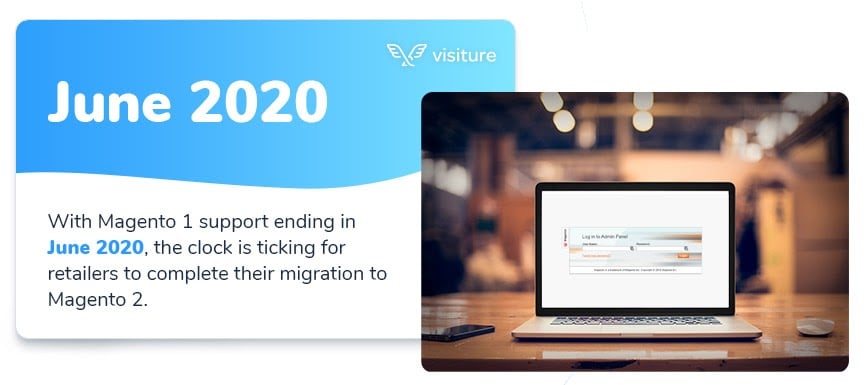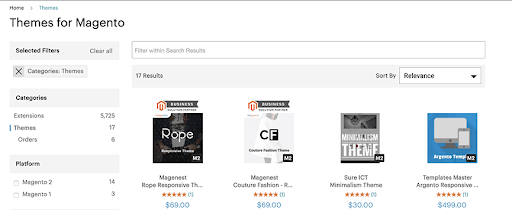Visiture is an end-to-end eCommerce marketing agency focused on helping online merchants acquire more customers through the use of search engines, social media platforms, marketplaces, and their online storefronts. Through search engine optimization, pay per click management, conversion rate optimization, development, and user experience design services; Visiture paves the way for online merchants to achieve higher returns from their online marketing channels.
After you’ve finished reading, make sure to visit our Magento Migration Resource page and schedule time to speak with an eCommerce expert about your transition.
Magento 1 End Life: What Merchants Need to Know
There are plenty of ways to make the most out of the Magento eCommerce platform. As of right now, the item which tops that list is to move from your soon to be sunsetted Magento 1.x.
While there are still plenty of sellers utilizing Magento 1, this particular iteration is soon to reach the end of its lifecycle. Therefore, sellers should be seriously considering their business’s next step–be it moving the store to Magento 2 or migrating to a different platform entirely.
There will be support for Magento 1 through June 2020, extending the original end-of-life date by a year and a half. However, after that point, depending on the version that sellers employ, the company will no longer provide software support or security patches, meaning that digital storefronts can quickly fall into an unmanageable situation.

For merchants who continue to use their Magento 1 version platform, the time is now to decide how the online business should move forward. To help make such essential decisions, we’re exploring Magento 1.x’s end-life, options retailers have at their disposal and how eCommerce brands can successfully migrate from Magento 1 to Magento 2.
Magento 1 Sunset Is on the Horizon
While the end of life for Magento 1 is a widely discussed development, the version hasn’t had any significant releases since way back in 2014. The reason for this is that the eCommerce platform provider had been investing the majority of its efforts into Magento 2, which was released in 2015.
However, when stacking Magento 1 and 2 against one another, it becomes immediately apparent that the latter is far superior as the company introduced upgraded performance and scalability elements, a heightened on-site user experience, faster load times, security improvements and scores of other benefits.

For instance, when Spanx unveiled its new Magento 2 website, the company benefited greatly from the platform’s innovative updates, ultimately achieving a 28 percent increase in its average order value.
However, due to the open-source nature of the platform, some sellers may not want (or have the ability) to migrate their store to the contemporary version of the platform.
For those folks, a switch may be in order.
Other eCommerce Platforms to Consider
While Magento’s open-source solution has historically been favored by businesses that have invested heavily in web development teams, there are fantastic options for those in pursuit of other ends.
For instance, BigCommerce is a leading eCommerce SaaS provider and a leading name in the headless commerce revolution, thanks to the company’s highly flexible APIs.
BigCommerce offers plans for start-ups, small businesses and more, supporting well-known brands like Skullcandy, Camelbak, YETI and many other notable names. Moreover, BigCommerce is SEO-friendly and features tons of integration options, making it a frontrunner for merchants looking to change their platform.
Alternatively, Shopify (or Shopify Plus) is another excellent SaaS eCommerce option for small stores with less than 100 SKUs, all the way up to Fortune 500 organizations.

Using Shopify, SculptHouse launched a new website that not only served to centralize customer data but also vastly improved on the brand’s design, user experience and other essential on-site elements.
However, for merchants who wish to stick with their current provider and move over to Magento 2, there are some key considerations to cover.
Vital Magento Migration Components
When it comes to migrating an eCommerce store from Magento 1 to Magento 2, there are three main components for retailers to consider.
Those elements include:
Data
Through utilizing the Magento 2 Data Migration Tool, merchants can securely move data to the Magento 2 platform without dropping packets along the way.
However, it is essential to remember that this is a time-intensive process that requires multiple steps, including product information, customer data, order data, store configurations and the like. Therefore, sellers are strongly advised to hire an experienced developer or agency to manage the process.
Extensions
Thanks to the extensive Magento community, many of the site’s more popular extensions have been updated and validated for the updated version of the platform. However, not all extensions that Magento 1 users employ will be functional on the new version of Magento.
Therefore, merchants must identify which will not carry over and replace those with comparable solutions.
Themes
Unfortunately, retailers cannot migrate their existing themes over to Magento 2.

However, there are a variety of new themes that retailers can choose from that are superior to their predecessors in many ways.
Alternatively, sellers can commission a designer or agency to create a custom theme for their new store.
With that said, let’s explore a quick overview of the migration process.
Migrating from Magento 1 to Magento 2
To begin, merchants must download the current version of Magento 2 without the data sample.
Next, sellers should download the data migration tool and configure it appropriately. This may require the assistance of a developer or agency.
From here, it is necessary to halt the current activities in Magento 1, place the site into maintenance mode and open the ports in the firewall to allow for proper communication and data transfer.
Finally, retailers can migrate extensions, customizations and other important system configurations like payment gateways and tax settings.
Magento 1 has reached the end of the road.
Retailers still using the platform must set a plan in motion to migrate their store to Magento 2 or another eCommerce platform before the June 2020 deadline.
Through this transition, merchants have the opportunity to grow their brand’s identity, functionality, user experience and bottom line.




